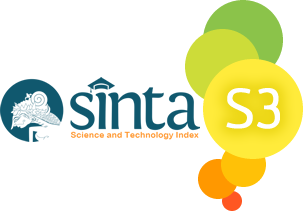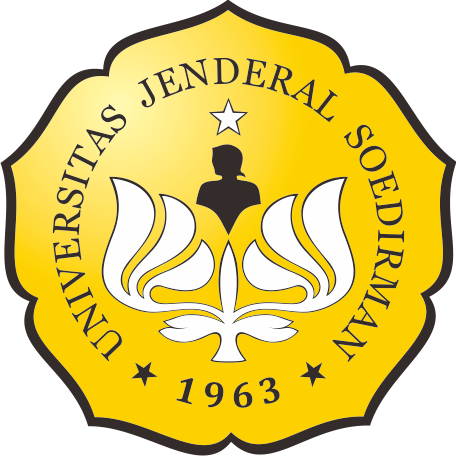AKTIVITAS ENZIM SUPEROKSIDA DISMUTASE TIKUS DIABETES YANG DIBERI EKSTRAK DAUN KAPULAGA Amomum cardamomum
Abstract
Diabetes is a disease characterized by abnormal insulin secretion, production, and insulin resistance. This condition cause oxidative stress which produce radical anion superoxide and decrease superoxide dismutase (SOD) activity. SOD is an antioxidant enzyme that can reduces anion superoxide which caused by diabetes. Many natural medicine are believed having the capacity to improve antioxidant status in the body. Cardamom’s leaf was reported containing flavonoids and vitamin C has been proven as in vitro antioxidant. However, there is no data that shows in vivo potency. This study was aimed to know the SOD activity of diabetic rats after treatment of cardamom’s leaf extract. This research used experimental method consist 2 treatment and 5 repetitions. First treatment was diabetic rats given a dose of 100mg/kg body mass of cardamom’s leaf extract (CLE) and second treatment was diabetic rats without CLE as control every day for 21 days. Blood sampling was performed 4 times : 0, 7, 14, 21 after treatment. Parameter measured were inhibition of ferricytokrom C reduction. Data were analyzed using unpaired t test. The result showed the highest SOD activity was 506.60 U/mg protein (P<0.01) in diabetic rats for 14 days CLE. The conclusions of this research are SOD activity increased after 14 days treatment of cardamom’s leaf extract.
Keywords
Full Text:
PDFReferences
Al-Katib SM, Al-Khasab EM, Kalo MS, Hamdoon AA. 2009. The Antioxidant Effects of Flavonoids and Non-Flavonoid Part Extract from Ginger ( Zingiber officinale) Roots. Journal Raf Sci. 20(3):18-31.
Amic D, Beslo D, Trinasjstic N. 2003. Structure-radical scavenging activity relationship of flavonoids. Croatica Chemical Acta. 76(1):56-61.
Arifin H, Vivi D, Almahdy A. 2007. Pengaruh Pemberian Vitamin C terhadap Fetus pada Mencit Diabetes. Jurnal Sains dan Teknologi Farmasi. 12(1):32-40.
Aylindania N. 2007. Pengaruh Pemberian Teh Hijau ( Camellia sinensis L.) terhadap Aktivitas Radikal Bebas pada Hepar Mencit (Mus musculus) Diabetes [Skripsi]. Universitas Islam Negeri (UIN) Malang, Malang.
Bradford MM. 1976. A Rapid and Sensitivity Method for Quantitation of Microgram Quantities of Protein Utilizing The Principles of Protein Dye-Binding. Anal. Biochem. 11:870-884.
Castenmiller JM, Soren T, Lauridsen, Dragsted LO, Karin H, Jozef PH, Clive E. 1999. B-Carotene does not change markers of enzymatic antioxidant activity in human blood. J Nutr. 129:2162-2169.
Chis IC, Ungureanu MU, Marton A, Simedrea R, Muresan A, Potescu I, Decea N. 2009. Departement of Physiology. University of Medicine and Pharmacy. Romania.
Day R, Lal SS. 2012. Supplementation effects of vitamin C and vitamin E on oxidative stress in post menopausal diabetic women. BioChemistry: An Indian Journal. 2012;6(4).
Devi SA, Umasankar ME, Babu S. 2012. A Comparative Study of Anti Oxidant Properties in Common Indian Spices. IRJP. 3(5):465-468.
El-Beshbishy HA. 2005. Hepatoprotective Effect of Green Tea ( Camellia sinensis) Extract against Tamoxifen-induced Liver Injury in Rats. Journal of Biochemistry and Molecular Biology. 38(5):563-570. https://doi.org/10.5483/bmbrep.2005.38.5.563
Firuzi O, Lacanna A, Petrucci R, Marrosu G, Saso L. 2005. Evaluation of The Antioxidant Activity of Flavonoid by “Ferric Reducing Antioxidant Power” Assay and Cyclic Voltammetry. Biochim Biophys Acta. 1721:174-184. https://doi.org/10.1016/j.bbagen.2004.11.001
Janson S, Erawan W, M. Akbar K. 2011. Pemberian Vitamin C Dikontraindikasikan pada Pengobatan Tuberkulosis dengan Isoniazid. Journal of the Indonesian Medical Students Association. 1(1):10-15.
Kim SJ, BJ, Choi WC, Kin CS. 2006. Hypoglycemic and Antihyperlipidemic Effect of Four Korean Medicinal Plants in Alloxan Induced Diabetic Rats. American Journal Biochemical Biotechnology. 2(4):154-160. https://doi.org/10.3844/ajbbsp.2006.154.160
Lu Y, Zhang Q, Li J, Sun Y, Wang L, Cheng W, Yang H. 2010. Antidiabetic Effects of Total Flavonoids from Litsea Coreana leve on Fat-Fed, Streptozotocin- Induced Type 2 Diabetic Rats. The American Journal of Chinese Medicine. 38(4):713-725. https://doi.org/10.1142/S0192415X10008184
Morakinyo AO, Akindele AJ, Ahmed Z. 2011. Modulation of Antioxidant Enzymes and Inflammatory Cytokines: Possible Mechanism of Anti-diabetic Effect of Ginger Extracts. Afr. J. Biomed. Res. 14:195-202.
Nathan MN, Buse JB, Mayer BD, Ferrannini E, Holman RR, Sherwin R, Zinman B. 2008. Management of Hyperglicemia in Type 2 Diabetes: A Consensus Alogarithm for Initiation and Adjustment of Therapy. Diabetes Care. 31(1):173-175. https://doi.org/10.2337/dc08-9016
Nijveldt RJ. 2001. Flavonoids: a Review of Probable Mechanism of Action and Potential Applications. The American Journal of Clinical Nutrition. 74:418-425.
Oxis Research. 2001. Spectrophotometric Assay for Superoxida Dismutase For Research Use Only Not For Use In Diagnostic Procedures. Oxis Health Product. USA.
Padayatty SJ, Are K, Yahoi W, Peter E, Oran K, Je-Hyuk L, Shenglin C, Crishtoper C, Anand D, Mark L. 2003. Vitamin C as Antoxidant: Evaluation of Its Role in Disease Prevention. Journal of the American College of Nutrition. 22(1):18-35. https://doi.org/10.1080/07315724.2003.10719272
Pattabiraman K, Muthukumaran P. 2011. Antidiabetic and Antioxidant Activity of Morinda tinctoria roxb Fruits Extract in Streptozotocin-Induced Diabetic Rats. Asian Journal Pharmacy Technology. 1(2):34-39.
Sadi G, Yilmaz O, Guray T. 2007. Effect of Vitamin C and Lipoic acid on Streptozotocin- induced Diabetes Gene Expression: mRNA and Protein Expressions of Cu-Zn SOD and Catalase. Mol Cell Biochem. 309:109-116. https://doi.org/10.1007/s11010-007-9648-6
Soegondo S. 2005. Penatalaksanaan Diabetes Melitus Terpadu. FKUI. Jakarta.
Srividya AR, Dhanabal SP, Satish KMN, Parth KHB. 2010. Antioxidant and Diabetic Activity of Alpinia Galanga. International Journal of Pharmacognosy and Phytochemical Research. 3(1): 6-12.
Sugihara N, Ohnishi M, Imamua K, Fuono K. 2001. Differences in Antioxidative Efficiency of Cathecins in Various Metal-induced Lipid Peroxidation in Cultured Hepatocytes. Journal of Health Science. 47(2): 99-106. https://doi.org/10.1248/jhs.47.99
Widowati. 2008. Potensi Antioksidan sebagai Antidiabetes. JKM. 7(2): 1-2.
Winarsi H, Sasongko ND, Purwanto A, Nuraeni I. 2012. Minuman Berbasis Ekstrak Kapulaga sebagai Antioksidan yang Berpotensi Antidiabetes. Laporan Penelitian MP3EI (tidak dipublikasikan). LPPM, Universitas Jenderal Soedirman.
Wiyono P. 2003. Peranan Hiperglikemia Terhadap Terjadinya Komplikasi Kronik Diabetes Melitus. B.I. Ked. 35(1):55-60.
Article Reads
Total: 2835 Abstract: 1235 PDF: 1600Refbacks
- There are currently no refbacks.

This work is licensed under a Creative Commons Attribution-ShareAlike 4.0 International License.
This website is maintained by:
Bio Publisher
The Faculty of Biology Publishing
Faculty of Biology
Universitas Jenderal Soedirman
Jalan dr. Suparno 63 Grendeng
Purwokerto 53122
Telephone: +62-281-625865
Email: biologi@unsoed.ac.id
T his website uses:
OJS | Open Journal System
A free journal management and publishing system that has been developed by the PKP (Public Knowledge Project) version 2.4.8.0.
All article content metadata are registered to:
Crossref
An official nonprofit Registration Agency of the International Digital Object Identifier (DOI) Foundation.
Articles in this journal are indexed by:









